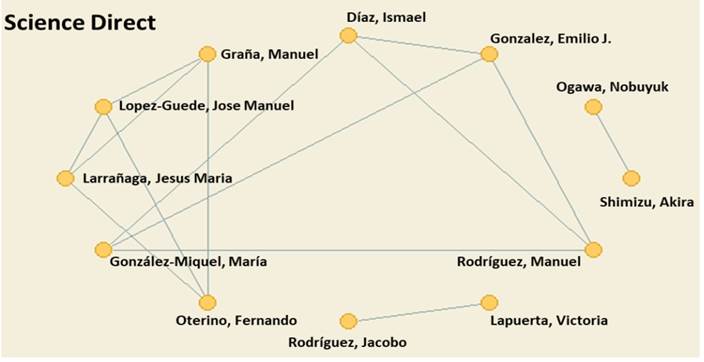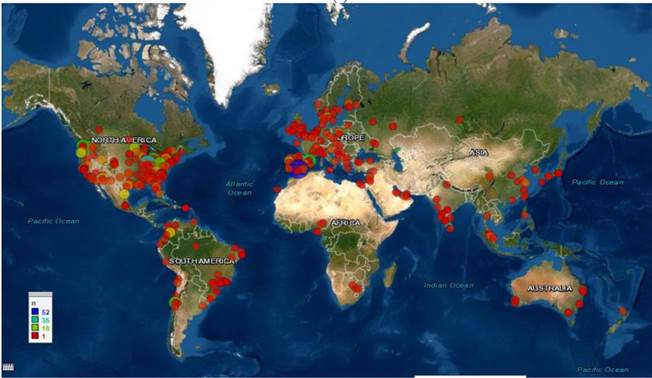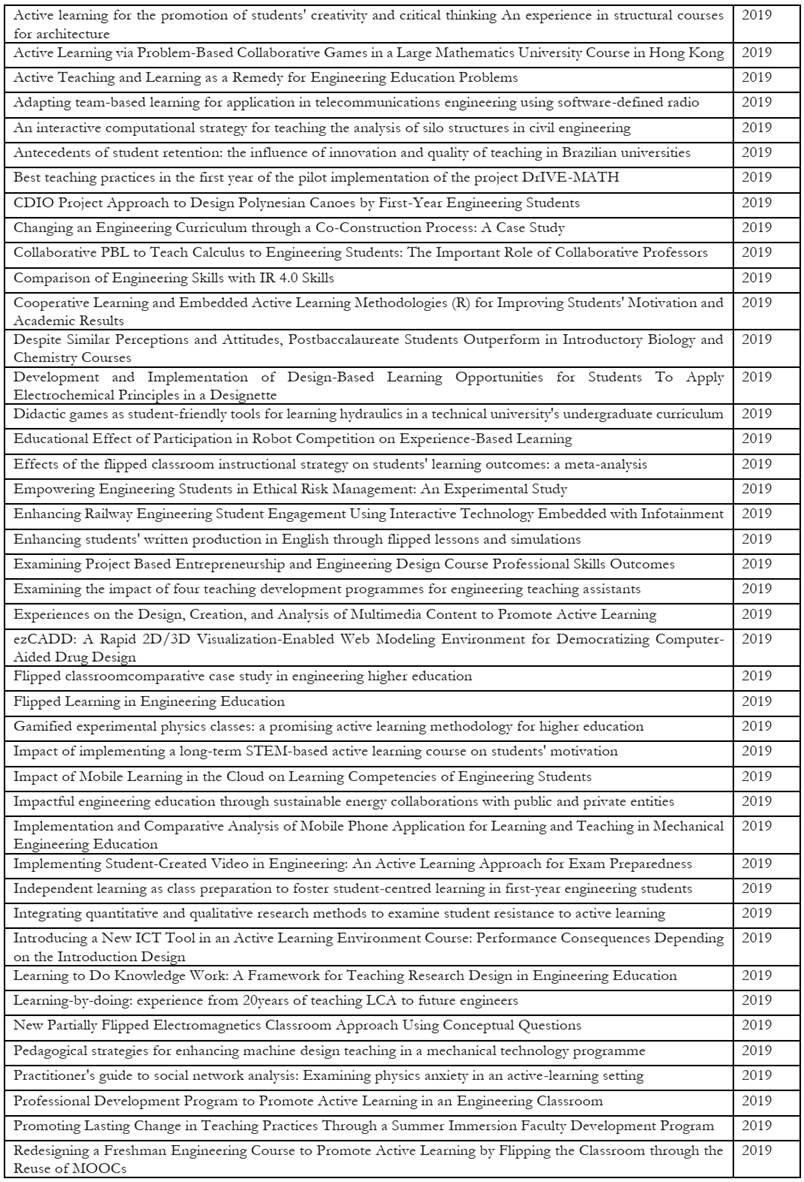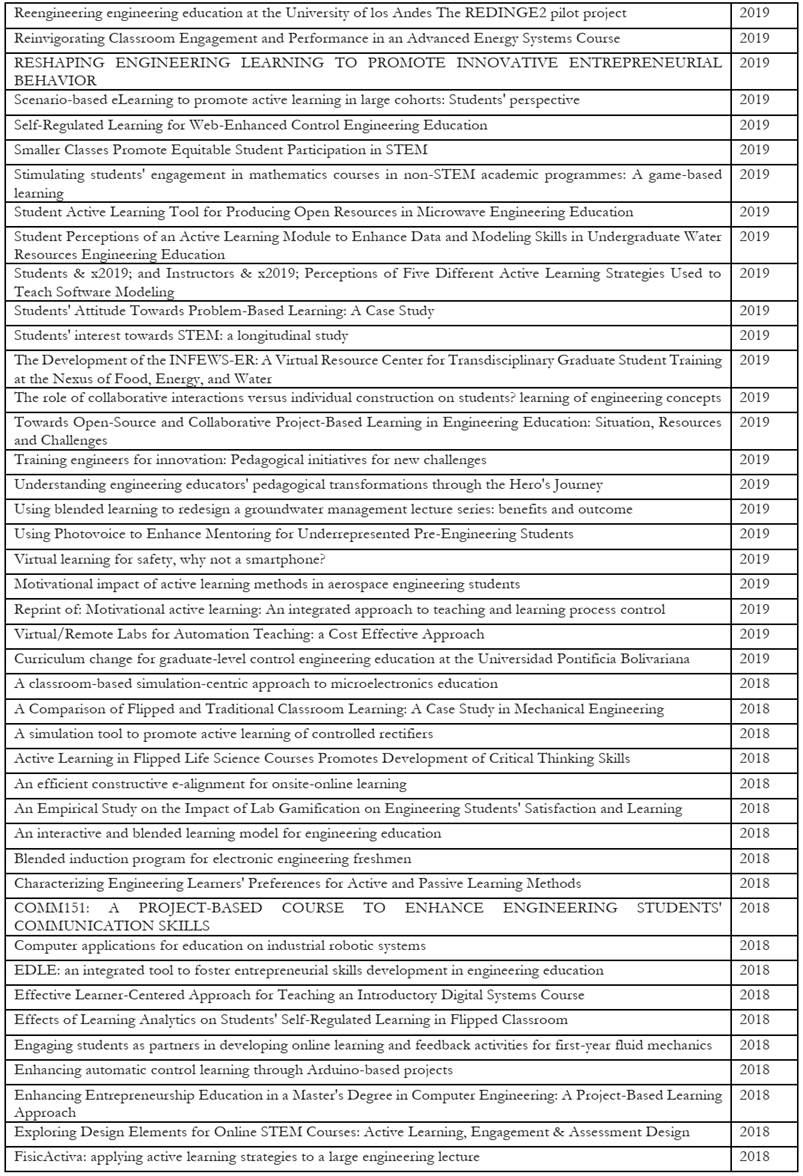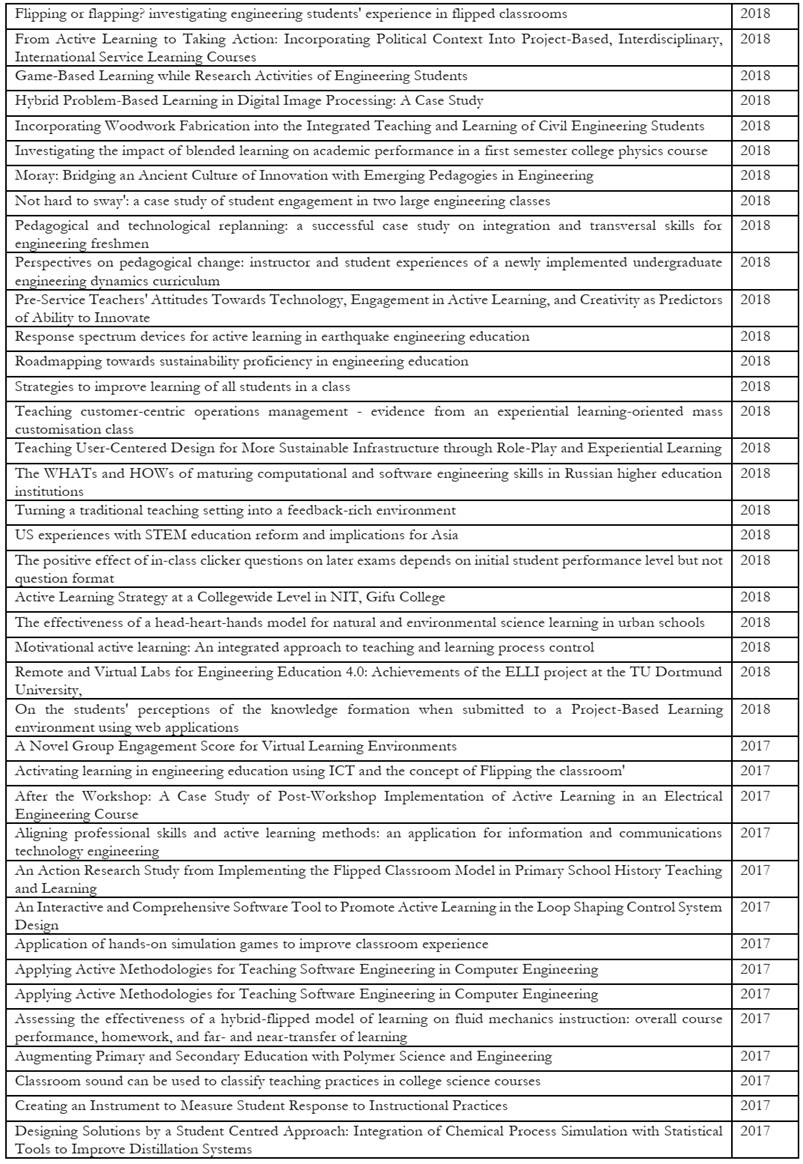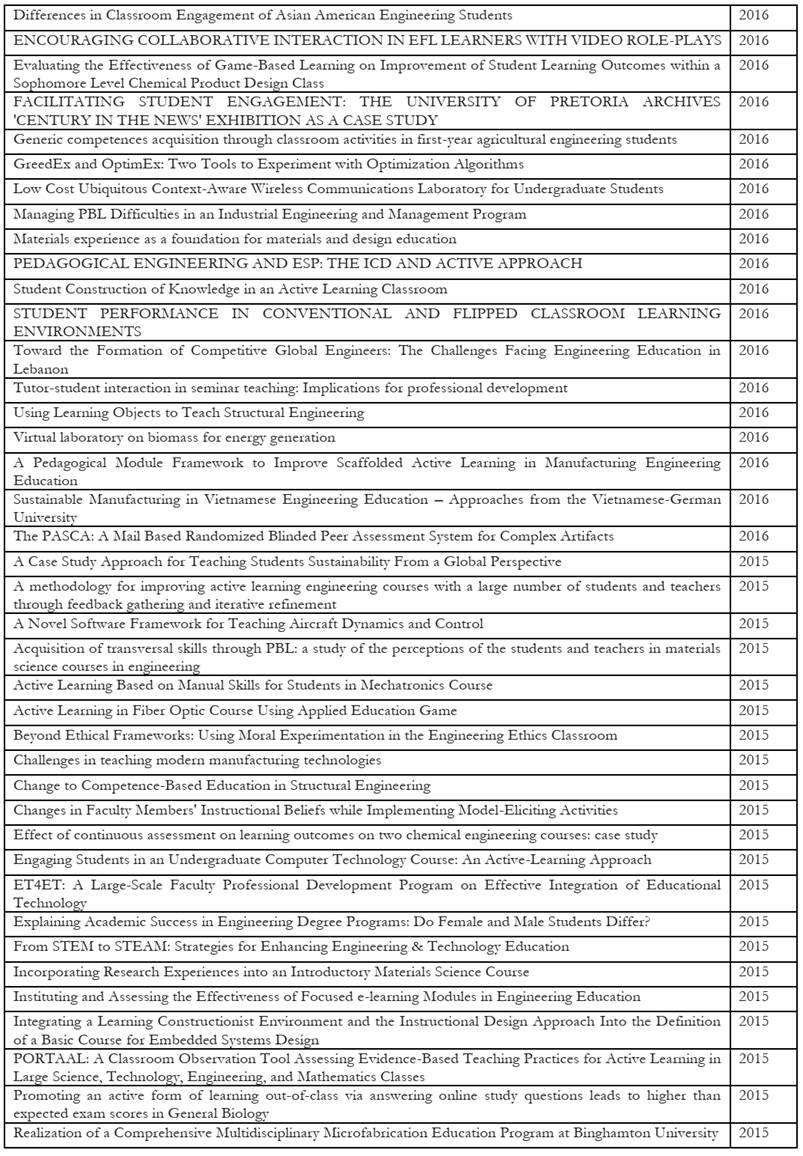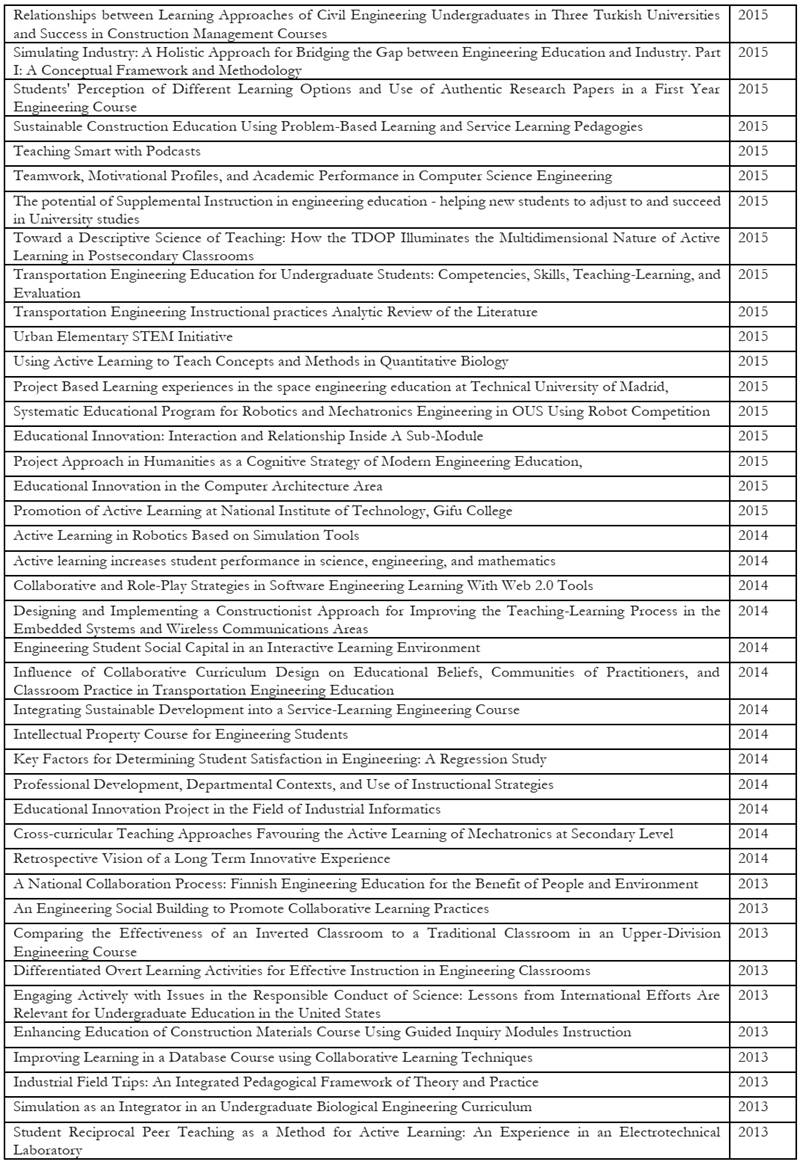Servicios Personalizados
Revista
Articulo
Compartir
Educação em Revista
versión impresa ISSN 0102-4698versión On-line ISSN 1982-6621
Educ. rev. vol.39 Belo Horizonte 2023 Epub 15-Sep-2023
https://doi.org/10.1590/0102-469839012
Relacionado con: https://preprints.scielo.org/index.php/scielo/preprint/view/3860
ARTICLE
ACTIVE METHODOLOGIES IN HIGHER EDUCATION: A SYSTEMATIC MAPPING IN THE CONTEXT OF ENGINEERING COURSES
1Universidade de São Paulo (USP). São Carlos, São Paulo (SP), Brazil
2PECEGE - Associado Profissional. Piracicaba, São Paulo (SP), Brazil.
Active learning is all pedagogical alternatives that place the focus of learning on the students. With the mediation of competent teachers, the students learn by discovery, by investigation, and by problems. Such methodologies commonly promote more content retention and comprehension once the students are engaged in activities, whether through research, group collaborations, discussion, and problem-solving. This work aimed to verify the temporal evolution of active learning methods in higher education Engineering courses, based on a systematic mapping of the literature. We observed which are the main researchers in this field, their geographic location, and which methodologies are preferred in the context of these courses. From the results, we observe a growth in scientific publications on active learning methodologies and Engineering Education, especially in the last five years of the period analysed (between 2015 and 2020). We also see research in this field on all continents, with a predominance of studies led by American and European researchers. In the mapped studies, the inverted classroom and problem-based learning were the most identified methodologies. It indicates a concern of teachers in this area to promote activities with high involvement, which allow the development of personal and professional skills and competencies, even during their training period.
Keywords: active learning; Engineering Education; Project-Based Learning; Problem-Based Learning; Flipped Classroom
As metodologias ativas podem ser entendidas como alternativas pedagógicas que colocam o foco do aprendizado nos estudantes. Com mediação de docentes competentes, os alunos aprendem a partir da descoberta, da investigação e por problemas. Tais metodologias comumente promovem uma maior retenção e compreensão de contéudos ensinados, uma vez que o aprendiz se encontra engajado nas atividades, seja por meio de pesquisa, colaborações em grupo, discussão e resolução de problemas. Este trabalho teve como objetivo verificar a evolução temporal do uso de metodologias ativas, no contexto dos cursos superiores de Engenharia, a partir de um mapeamento sistemático da literatura. A partir de um protocolo de pesquisa estabelecido, buscou-se verificar quais os principais pesquisadores desta área, sua localização geográfica e quais as metodologias preferidas no contexto destes cursos. A partir dos resultados, foi possível observar que o crescimento do número de publicações científicas sobre metodologias ativas no contexto da Educação em Engenharia, em especial nos últimos cinco anos do período analisado (entre 2015 e 2020). Pode-se notar a realização de pesquisas neste contexto em todos os continentes, com predomínio de estudos liderados por pesquisadores americanos e europeus. Nos estudos mapeados, a sala de aula invertida e a aprendizagem baseada em problemas foram as metodologias mais identificadas. Isso indica uma maior preocupação dos professores da área em promover atividades com elevado envolvimento, que permitam o desenvolvimento de habilidades e competências pessoais e profissionais, ainda no período de formação.
Palavras-chave: metodologias de ensino; Educação em Engenharia; aprendizagem baseada em projetos; aprendizagem baseada em problemas; sala de aula invertida
Las metodologías activas pueden entenderse como alternativas pedagógicas que ponen el foco del aprendizaje en los alumnos. Con la mediación de profesores competentes, los alumnos aprenden a partir del descubrimiento, la investigación y los problemas. Estas metodologías suelen promover una mayor retención y comprensión de los contenidos enseñados, ya que el alumno participa en actividades, ya sea a través de la investigación, la colaboración en grupo, el debate y la resolución de problemas. Este trabajo tuvo como objetivo verificar la evolución temporal del uso de las metodologías activas en el contexto de los cursos de educación superior en Ingeniería, a partir de un mapeo sistemático de la literatura. A partir de un protocolo de investigación establecido, se buscó verificar cuáles son los principales investigadores en esta área, su ubicación geográfica y cuáles son las metodologías preferidas en el contexto de estos cursos. A partir de los resultados, se pudo observar que el crecimiento en el número de publicaciones científicas sobre metodologías activas en el contexto de la Enseñanza de la Ingeniería, especialmente en los últimos cinco años del período analizado (entre 2015 y 2020). Se puede observar la realización de investigaciones en este contexto en todos los continentes, con un predominio de estudios dirigidos por investigadores americanos y europeos. En los estudios mapeados, el aula invertida y el aprendizaje basado en problemas fueron las metodologías más identificadas. Esto indica una mayor preocupación entre los profesores de la zona por promover actividades con alta implicación que permitan el desarrollo de habilidades y competencias personales y profesionales durante el periodo de formación.
Palabras clave: metodologías de enseñanza; enseñanza de la ingeniería; aprendizaje basado en proyectos; aprendizaje basado en problemas; aula invertida
INTRODUCTION
Active methodologies can be understood as teaching methods that actively involve students during the learning process. Through meaningful actions and activities, students reflect on what they are doing and what they are learning. Alternatively, such approaches can be mentioned in the literature as inductive teaching. These methods are similar because the student assumes greater responsibility and protagonism for their learning, which may be based on research and/or collaborative activities, involving discussion and problem-solving. The teacher is a facilitator of learning, not acting as a primary source of knowledge, evaluating, and observing his students’ progress, and providing the necessary assistance at specific times. As a result of student engagement, there is greater retention and understanding of the content covered, as well as greater attention and concentration on the proposed activities (Hernández-de-Menéndez et al.; 2019; Prince, 2004; Prince and Felder, 2006).
Despite recent and modern, active methodologies were already highlighted by classic authors in Education at the beginning of the 20th century, such as John Dewey and Lev Vygotsky, in the context of school education for children and young people. The first emphasized the importance that the knowledge passed on in the classroom should always be introduced by real situations, which would generate students' interest in learning since education should be considered as a life process and not as a preparation process for a future life (Williams, 2017). The second one indicated interactive activities such as productive discussions, constructive feedback, and collaboration with others, as fundamental for the construction of knowledge, with the teacher being the main promoter and motivator of this type of interaction (Kurt, 2020). Both characteristics emphasized by these authors are fundamental pillars of active methodologies applied in current times.
Even with the different advantages and good results of using active methodologies, most teachers still prefer traditional methodologies, especially teachers in the areas of Science, Technology, Engineering, and Mathematics (STEM) (Stains et al. 2018). The main reasons given by teachers are the insufficient time to prepare classes with new methodologies, limited resources, lack of institutional support, difficulty in approaching content and making assessments using such approaches, students' resistance to participating in the proposed active activities, in assuming responsibility for their learning and being forced to carry out group activities (Deslauriers et al., 2019; Felder, 2010; Henderson et al., 2007).
Despite these facts, universities and professors in their initiatives, have considered the different benefits of active methodologies and have invested in environments and situations conducive to their adoption in higher education curricula (Hernández-de-Menéndez et al.; 2019). The need to train professionals with technical skills combined with problem-solving skills, present in the day-to-day activities of professions, encourages the use of these approaches with university students, in the most different areas. The development of skills and abilities valued by the labor market, such as critical thinking, analysis, problem-solving, leadership, teamwork, and the use of information and communication technologies, among others; are also attractive consequences of the use of active methodologies (Prince and Felder, 2006).
The Covid-19 pandemic, social distancing actions, and the sudden deployment of remote learning have also accelerated the use of active approaches. In this context, professors were challenged to maintain attractive and quality teaching through computer screens, cell phones, and TVs. The use of methods of greater student engagement, together with technological tools, has a high potential for maintaining performance and learning, even in times when face-to-face meetings were not possible (Donitsa-Schimdt and Ramot, 2020; Palmeira et al., 2020; Singhal et al., 2020).
Considering this context, the general objective of this work is to verify the temporal evolution, in Brazil and the world, of the use of active methodologies in the context of higher education courses in Engineering, through a systematic mapping of the literature. Specifically, we seek to identify the main researchers involved in research in this area in recent years, and their geographic location, in addition to verifying the Brazilian presence in these researches. Based on a brief analysis of the titles, abstracts, and keywords of the listed works, the aim is to identify which active methodology is most used by professors of higher education courses in Engineering. Thus, the aim is to understand how such methodologies have entered the classrooms of these courses and how teachers and students have received this change in the teaching-learning process.
MATERIALS AND METHODS
This work consists of a systematic mapping, which according to Kitchenham and Charters (2007), corresponds to a secondary study aimed at identifying and classifying a theme/content related to a research topic. Its results allow a broad investigation of the chosen theme, enabling the investigation of the main characteristics, conclusions, and gaps in the literature, as well as the suggestion of new studies and the use of new methods, approaches, and/or approaches. Performing systematic mapping requires the construction of a research protocol, consisting of seven basic steps (Petersen et al., 2008; Petersen et al., 2015), illustrated in Figure 1.

Figure 1 - Seven basic steps of the systematic mapping research protocol (Source: Adapted from Petersen et al., 2015)
For this work, such steps were defined as follows:
1. Research questions: initially, 4 research questions were defined to be answered in this systematic mapping:
Is it possible to observe a growth in the use of active methodologies in Engineering courses, based on the publications found by the established research protocol and for the selected period of study?
Which journals are the main vehicles for disseminating works involving active methodologies in higher education courses in Engineering? Who are the authors and how are they connected in the production of such works?
What is the geographic distribution of the researchers who published works in this period? Is it possible to establish a profile of the Brazilian presence in this research?
When evaluating the titles, abstracts, and keywords of the selected works, is it possible to identify the active methodologies most used/reported by researchers?
2. Search engines: Web of Science (WoS) and ScienceDirect (SciDir). Such platforms were chosen because they include journals that publish results in the areas of Engineering.
3. Language: English. The choice of this language considers its majority use in scientific publications and the mandatory use of the listed search engines.
4. Search string (or descriptors): (“active learning”) AND (“education”) AND (“engineering”). The search terms include English words commonly used in publications that address active methodologies and education in the context of higher education courses in Engineering.
5. Research period: 2005 to 2020. It is believed that the fifteen-year interval is interesting to investigate established research questions. At the same time, it will be possible to establish a scenario before the Covid-19 pandemic, which may have stimulated the use of active methodologies.
6. Inclusion criteria: works that have the search strings in the title, abstract, and keywords will be considered.
7. Exclusion criteria: only original research papers will be considered (“Article type - Research articles” filter in Science Direct and “Document type - Articles” filter in Web of Science).
With the application of this protocol, data extraction was performed, resulting in a list of primary studies. The data in this list were summarized in graphs and tables, prepared using the following computational tools:
BibExcel (Persson et al., 2009): a tool for analyzing bibliographic data, extracted from search engines in textual form, which can be converted into electronic spreadsheets, for quantitative analysis and graph generation.
Pajek (Nooy et al., 2018): a tool for generating collaboration networks between article authors, from files generated in the analysis with the BibExcel tool.
GPS Visualizer: online tool for producing maps, based on location data from the authors of the studies listed in this systematic mapping.
WordCloud: an online tool for producing a cloud of words present in the titles, abstracts, and keywords of the listed studies.
This data synthesis sought to find answers to the research questions established for this systematic mapping. Such responses include verifying the advancement of the presence of the theme of active methodologies in higher education courses in Engineering over the last few years; the identification of the main vehicles for disseminating such research and which are the main researchers involved and the identification of the active methodologies preferred by professors in the field of Engineering.
RESULTS AND DISCUSSION
The application of the established research protocol found 433 original research papers, with 55 results obtained from Science Direct (SciDir) and 378 results obtained from Web of Science (WoS). We verified the existence of 17 repetitions, which were found in both search engines, but they were withdrawn and considered only once. Thus, the final number considered was 416 publications, which are indicated in Appendix A (title and year of publication).
The temporal distribution of publications is presented in Figure 2, considering the established search period, between 2005 and 2020. This figure differentiates the works found in each search engine, in addition to indicating the accumulated total of publications each year. The years with the highest total number of published works were 2019, with 73 publications (17.5% of the total), 69 from WoS and 4 from SciDir; and 2020, with 71 publications (17.1% of the total), 57 from WoS and 14 from SciDir.
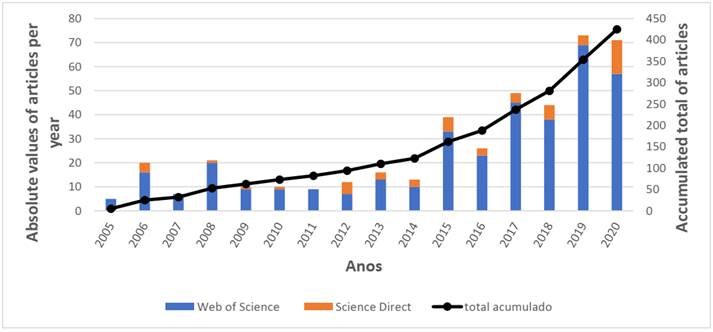
Figure 2 Evolution of the number of scientific publications on active methodologies in higher education engineering courses, considering the established research protocol (Source: Authors, 2023).
It is possible to observe a significant increase in the number of works published from 2015. Until that year, the total number of published works was 153, which is equivalent to 36.8% of the publications found in this mapping. Between 2015 and 2020, 263 scientific articles were published on active methodologies in higher engineering courses, corresponding to 63.2% of the works mapped and 1.72 times the number of works identified between 2005 and 2015.
Such results are indicative of the growth of the presence of active methodologies in the classrooms of higher education courses in Engineering, with an acceleration of their uses and the reports present in the international scientific literature after 2015 and with peaks in the last two years of the period of survey considered (2019 and 2020). The repetition of this research protocol, in a later period, may be interesting to find out how the extension of the Covid-19 pandemic may have affected this growth, considering the context of social isolation and remote teaching.
The works mapped here were published in 124 different scientific journals. Figure 3 highlights the five journals with the highest number of publications in this mapping and the respective number of works published in these journals.

Figure 3 Journals with the highest number of scientific publications on active methodologies in higher education courses in Engineering, considering the established research protocol. (Source: Authors, 2023)
The journal that presented the largest number of papers was the International Journal of Engineering Education (IJEE / ISSN: 0949-149X) with 84 articles, which corresponds to 20.1% of the mapped publications. Then, with 34 papers (8.2% of the total), there is the European Journal of Engineering Education (EJEE / ISSN: 0304-3797). Both journals currently publish six editions per year and have in their scopes the dissemination of scientific research focused on the development of education focused on Engineering, on a global and continental level.
The journals IEEE Transactions on Education (IEEE ToE / ISSN: 0018-9359) and Computer Applications in Engineering Education (CAE / ISSN: 1061-3773) were, respectively, the third and fourth journals with more publications in this mapping. IEEE ToE is linked to the Institute of Electrical and Electronics Engineers (IEEE) and seeks to carry out educational research linked to higher education courses in Electrical, Electronics, and Computer Engineering. This result highlights the presence of this area of Engineering among those that most disseminate their results of active methodologies in the scientific literature. The CAE journal, on the other hand, addresses studies on the use of computers, the Internet, tools, and software, in the context of Engineering education, which also highlights the initiatives of teachers to include new technologies, combined with active methodologies, in the context of student training.
Figure 4 shows the five authors most present in the analyzed studies. This survey considered both the position of the main author and co-author of the works. In the 416 works analyzed, 671 researchers were involved, which corresponds to an average of 1.61 researchers involved per work. Maura Borrego (University of Texas at Austin, USA) was the researcher with the largest number of papers, with 6 participations, 4 of which as first author. Shane Brown (Oregon State University, USA) was second, with 5 participations, 2 as lead author. Jeffrey Rhoads (University of Purdue, USA), Noboyuki Ogawa (Gifu National College of Technology, Japan), and José Manuel Lopez-Guede (Universidad del Pais Vasco, Spain) complete the list. An interesting fact common to such researchers is their initial training in Engineering and the carrying out of further studies, seeking to integrate active methodologies into the courses they belong to.

Figure 4 Authors with the highest number of participations in works, considering the established research protocol (Source: Authors, 2023)
Figures 5a and 5b show the connection networks between the authors involved in the studies listed in this mapping, divided by search engine (Science Direct and Web of Science, respectively). A link indicates that an author has published at least one paper with another. It is not possible to present all 671 researchers involved in these figures of all existing connections. In this way, the most frequent connections are displayed in the figures.
It is interesting to note that the interaction between these authors is not intense, which indicates the need for more local studies, which report experiences at each university or each course in which they are involved. Even the authors with more publications, shown in Figure 3, have few collaborations. Maura Borrego and Noboyuk Ogawa have a single frequent collaboration, while José Manuel Lopez-Guede has three frequent connections, all of which are of the same nationality. Shane Brown and Jeffrey Rhoads do not appear in these networks, since their work was always carried out with different professionals, infrequent in the dissemination of results through articles.
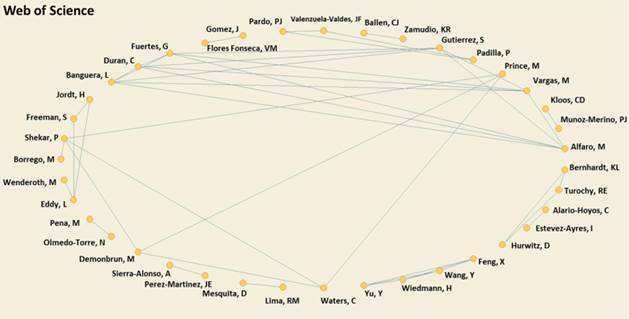
Figure 5 Connection networks between authors participating in the works, divided according to the search engine: (a) Science-Direct and (b) Web of Science. (Source: Authors, 2023)
When we look at the list of authors with the most works and the most frequent connection networks, it is possible to assess that there is a predominance of American and European authors, especially Spanish ones. This assessment can be confirmed in Figure 6, which shows the geographic location of the researchers involved in the work listed in this mapping. This evaluation was carried out only for works obtained by the Web of Science search engine, since the search results on this platform, in textual format, provided such information, while Science Direct did not.
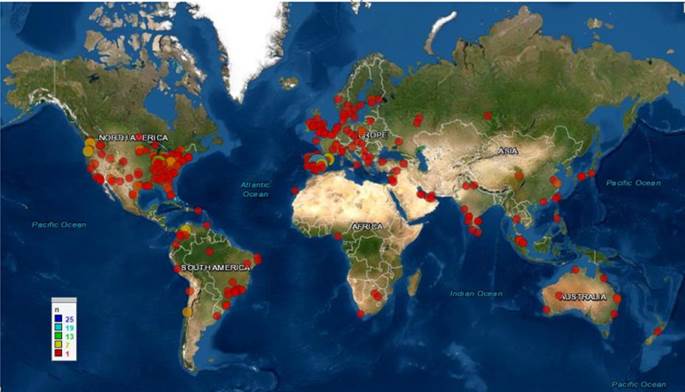
Figure 6 Location map of researchers involved in the research listed in this systematic mapping, from the Web of Science. Circle size and colors indicate quantities in each city/region. (a) location of all authors involved; (b) locations that presented 10 or more works; (c) places of origin of the first authors. (Source: Authors, 2023)
Observing all the authors (Figure 6a), it is possible to assess the predominance of the point cloud over the United States and Europe. Colored circles with a larger diameter indicate the locations with the greatest presence of researchers. Madrid (Spain) with 59 repetitions; West Lafayette (United States) with 39 repetitions; and Barcelona (Spain) with 29 repetitions are the cities with more authors participating in the listed surveys.
The American and European predominance over the other continents is even more evident in Figure 6b, which restricts the locations that presented at least 10 repetitions. In this condition, it is noted the lack of points in Asia, Oceania, and Africa, in addition to a large reduction in the presence of works from South America. In this last region, the works carried out in Chile and Colombia stand out, which in terms of the same location, presented more papers than Brazil.
Figure 6c shows the location of the first authors. The European and American predominance remains evident, considering that these regions have a research network on the subject and investments in science already consolidated, making them the main international references (Reis et al., 2017). The presence of researchers leading publications on all continents is an encouraging fact, in the sense that active methodologies are already widespread worldwide and that there is a concern on the part of Engineering professors to bring them to the classroom.
Figure 7 shows a clipping of the maps for the South American continent to highlight Brazil. When comparing the map of all authors (Figure 7a) and the map of first authors (Figure 7b), there is a lot of similarity, which indicates that Brazilian researchers, in different regions, led research related to active methodologies aimed at Engineering courses. Numerically speaking, 40 researchers participated in such works, and 17 of these have a Brazilian researcher as the first author. Four of the five Brazilian regions had at least one participation in works on active methodologies. Only the Midwest region did not have representatives. The highest concentration of articles was seen in the South and Southeast regions, with papers coming from both capitals and cities in the interior. Despite this optimistic approach, it is believed that Brazil can still evolve in carrying out research and implementing active methodologies in Engineering courses. It is important to point out that the protocol of this research only collected works published internationally and that many researchers may choose to disseminate their research nationally, through journals and events in the country, whose papers were not captured in this survey.

Figure 7 Location of Brazilian and South American researchers involved in the research is listed in this systematic mapping, from the Web of Science. Circle size and colors indicate quantities in each city/region. (a) location of all authors involved; (b) places of origin of the first authors. (Source: Authors, 2023)
Finally, Figure 8 shows three-word clouds obtained from the texts of the titles (Figure 8a), abstracts (Figure 8b), and keywords (Figure 8c) of the papers. The assembly of these word clouds disregarded the terms “active learning”; “education” and “engineering”, which were used as research criteria in the present studies and would inevitably be present in high quantity in these word clouds. We tried to verify the terms with more repetitions and that could be indicative of the active methodologies reported by the authors in each study. Words with larger fonts are indicative of greater repetitions.

Figure 8 Word clouds are obtained from (a) titles; (b) abstracts and (c) keywords of all papers listed in this mapping. Words with larger fonts had a higher number of repetitions. (Source: Authors, 2023)
In the analysis of these results, we tried to group the words into categories to list indicative reasons for their repetition in the evaluated texts. The categories were:
Words with many repetitions that describe elements of the university, which are inevitably used in the description of the environment in which the publications were carried out. The terms “student” (estudente); “course(s)” (cursos); “classroom” (sala de aula); “practices” (prácticas); “strategies” (estratégias); “curriculum” (currículo); “higher education” (ensino superior);
• Words with many repetitions that describe elements of scientific works: common words of the language of scientific articles, such as “study” (estudo/trabalho); “research” (pesquisa); “outcomes” (resultados); “results” (resultados, resulta em); “impact” (impactos); “change” (mudanças); “analysis” (análise); “improving” (melhorias).
Words related to engineering and technology: terms such as “desgin” (projeto); “development” (desenvolvimento); “technology” (tecnologia); “digital” (digital); “simulation” (simulação); “systems” (sistemas); “tools” (ferramentas); which are words commonly present in the vocabulary of engineers and which may be embedded in the disciplines in which the active methodologies were applied.
Words related to skills and competences developed by students: they may have been used to describe the main results expected and obtained with the implementation of active methodologies. Terms like “skills” (habilidades); “analysis” (capacidade de análise); “management” (capacidade de gerenciamento); “communication” (comunicação); “groups” e “teamwork” (trabalho em grupo); creativity” (criatividade) are the most prominent in this category.
Words related to active methodologies: “flipped” (inverted, which refers to the flipped classroom); ‘Project-based” and “PBL” (problem and project-based learning); were the most repeated terms regarding active methodologies. Secondarily, the terms “blended” (blended teaching); “peer” (about peer learning)” and “case” (about case studies). Such approaches can be considered the most used and reported by the authors of the publications listed in this mapping.
The results regarding the preferred and most cited active methodologies in the texts coincide with those seen by other authors in previous bibliographic studies (Jesiek et al., 2011; Reis et al., 2017; Wankat et al., 2014; Xian and Madhavan, 2014), which presented different search protocols, considering the searched terms, the search engines, and the analyzed search period. In this sense, Engineering professors have given preference to the use of methods that facilitate the integration between theory and practice, a common demand of students in these courses, who in traditional teaching, suffer from distance from the classroom of true professional reality.
The skills and abilities developed with these methodologies, also identified in the evaluated terms, are a direct result of the use of active teaching and contribute to the student's personal and professional development. In addition, they are in line with the new focus of university education, where not only dealing with technical content is important but engaging and promoting meaningful learning are also fundamental for the success of graduates (Ríos et al., 2010; Hernández-de- Menéndez et al.; 2019).
CONCLUSÕES
The implementation of the proposed research protocol resulted in a list of 416 scientific publications, obtained from the Science Direct and Web of Science platforms. The analysis of this list allowed the verification of the temporal distribution of publications, which allowed observing a strong growth in the dissemination of scientific works linked to active methodologies in the context of higher education courses after 2015. In this period, 63.2% of the works mapped were published, with 2019 and 2020 together representing 34.6% of the total number of publications. It was also noted that 124 journals received the listed publications, with 20.1% of them published by the International Journal of Engineering Education (IJEE / ISSN: 0949-149X).
The mapping of researchers and their location indicated the predominance of research carried out by Americans and Europeans, with emphasis on Spanish researchers. Maura Borrego (University of Texas at Austin, USA), Shane Brown (Oregon State University, USA), Jeffrey Rhoads (University of Purdue, USA), Noboyuki Ogawa (Gifu National College of Technology, Japan), and José Manuel Lopez-Guede (Universidad del Pais Vasco, Spain) were the researchers who most participated in publications in the analyzed period. It was possible to observe research carried out on all continents, which indicates that professors of Engineering courses have been open to the use of active methodologies and that future perspectives can be interesting, in the sense of favoring learning in these courses. Brazil also participates in international research on the subject, with 40 researchers as authors and co-authors of these publications, from four of the five regions of the country. There is a predominance of researchers located in the South and Southeast of the country, being both in capitals and in the interior of the states.
From the evaluation of the terms present in the titles, abstracts, and keywords of the studies listed in this mapping, it was possible to observe that the most present active methodologies were the flipped classroom, problem-based learning, and project-based learning. Such methodologies are easily adaptable to the reality of the contents of Engineering courses and facilitate the integration between theory and practice, which can motivate teachers to seek its implementation, in a moment of transition between traditional teaching and active teaching.
As recommendations for future research, we believe that a short-term evaluation of the use of active methodologies in Engineering courses is important, as a way of identifying the effects of the pandemic and remote teaching on its implementation in the classroom. The identification of the growth of new methodologies, which surpass those identified in this work, can also be a result identified in this repetition. The inclusion of other platforms and other scientific works, not just articles, are also possible modifications in the methodology proposed here and that allow obtaining different insights about active teaching in Engineering. Finally, crossing the results obtained from Engineering courses with other undergraduate courses is a possibility to increase the set of methodologies that can be used with engineers. An analysis of the reality of each area of Engineering is also another interesting aspect of future research.
REFERENCES
Deslauriers, L., McCarty, L. S., Miller, K., Callaghan, K., Kestin, G. (2019). Measuring actual learning versus feeling of learning in response to being actively engaged in the classroom. Proceedings of the National Academy of Sciences, 116(39), 19251-19257. https://doi.org/10.1073/pnas.1821936116 [ Links ]
Donitsa-Schmidt, S., Ramot, R. (2020). Opportunities and challenges: Teacher education in Israel in the COVID-19 pandemic. Journal of Education for Teaching, 46(4), 586-595. https://doi.org/10.1080/02607476.2020.1799708 [ Links ]
Felder, R. M. (2010). Random thoughts: The link between teaching and research. 2. How to strengthen each without weakening the other. Chemical Engineering Education, 44(3), 213-214. [ Links ]
Henderson, C., Dancy, M. H. (2007). Barriers to the use of research-based instructional strategies: The influence of both individual and situational characteristics. Physical Review Special Topics - Physics Education Research, 3(2). https://doi.org/10.1103/physrevstper.3.020102 [ Links ]
Hernández-de-Menéndez, M., Vallejo Guevara, A., Tudón Martínez, J. C., Hernández Alcántara, D., Morales-Menendez, R. (2019). Active learning in engineering education. A review of fundamentals, best practices and experiences. International Journal on Interactive Design and Manufacturing (IJIDeM), 13(3), 909-922. https://doi.org/10.1007/s12008-019-00557-8 [ Links ]
Jesiek, B. K., Borrego, M., Bedoes, K., Hurtado, M., Rajendran, P., Sangam, D. (2011). Mapping Global Trends in Engineering Education Research, 2005-2008B. Mapping Global Trends in Engineering Education Research, 2005-2008, 27(1), 77-90. [ Links ]
Kitchenham, B. A. & Charters, S. (2007). Guidelines for performing Systematic Literature Reviews in Software Engineering (EBSE 2007-001). Keele University and Durham University Joint Report. [ Links ]
Kurt, D. S. (2020, July 11). Lev Vygotsky - Sociocultural theory of cognitive development. Educational Technology. Retrieved February 3, 2023, fromhttps://educationaltechnology.net/lev-vygotsky-sociocultural-theory-of-cognitive-development/ [ Links ]
Nooy, W. de, Mrvar, A., Batagelj, V. (2018). Exploratory social network analysis with Pajek: Revised and expanded edition for updated software. Cambridge University Press. [ Links ]
Palmeira, R. L., Da Silva, A. A., Ribeiro, W. L. (2020). As Metodologias Ativas de Ensino e Aprendizagem em Tempos de pandemia: A utilização dos recursos tecnológicos na educação superior. HOLOS, 5, 1-13. https://doi.org/10.15628/holos.2020.10810 [ Links ]
Persson, O., Danell, R., & Schneider, J.W. (2009). How to use Bibexcel for various types of bibliometric analysis. In: Celebrating scholarly communication studies: A Festschrift for Olle Persson at his 60th Birthday, ed. F. Åström, R. Danell, B. Larsen, J. Schneider. Leuven, Belgium: International Society for Scientometrics and Informetrics. p 9-24. [ Links ]
Petersen, K., Feldt, R., Mujtaba, S., Matsson, M. (2008). International Conference on Evaluation and Assessment in Software Engineering. In Proceedings of the International Conference on Evaluation and Assessment in Software Engineering (pp. 68-77). Bari, Italy; University of Bari. [ Links ]
Petersen, K., Vakkalanka, S., Kuzniarz, L. (2015). Guidelines for conducting Systematic Mapping Studies in Software Engineering: An update. Information and Software Technology, 64, 1-18. https://doi.org/10.1016/j.infsof.2015.03.007 [ Links ]
Prince, M. (2004). Does active learning work? A review of the research. Journal of Engineering Education, 93(3), 223-231. https://doi.org/10.1002/j.2168-9830.2004.tb00809.x [ Links ]
Prince, M. J., Felder, R. M. (2006). Inductive teaching and learning methods: Definitions, comparisons, and Research Bases. Journal of Engineering Education, 95(2), 123-138. https://doi.org/10.1002/j.2168-9830.2006.tb00884.x [ Links ]
Reis, A. C., Barbalho, S. C., Zanette, A. C. (2017). A bibliometric and classification study of Project-Based Learning in Engineering Education. Production, 27(spe). https://doi.org/10.1590/0103-6513.225816 [ Links ]
Ríos, I. de, Cazorla, A., Díaz-Puente, J. M., Yagüe, J. L. (2010). Project-Based Learning in Engineering Higher Education: Two decades of teaching competences in Real Environments. Procedia - Social and Behavioral Sciences, 2(2), 1368-1378. https://doi.org/10.1016/j.sbspro.2010.03.202 [ Links ]
Singhal, R., Kumar, A., Singh, H., Fuller, S., Gill, S. S. (2020). Digital device‐based active learning approach using virtual community classroom during the COVID‐19 pandemic. Computer Applications in Engineering Education, 29(5), 1007-1033. https://doi.org/10.1002/cae.22355 [ Links ]
Stains, M., Harshman, J., Barker, M. K., Chasteen, S. V., Cole, R., DeChenne-Peters, S. E., Eagan, M. K., Esson, J. M., Knight, J. K., Laski, F. A., Levis-Fitzgerald, M., Lee, C. J., Lo, S. M., McDonnell, L. M., McKay, T. A., Michelotti, N., Musgrove, A., Palmer, M. S., Plank, K. M., … Young, A. M. (2018). Anatomy of STEM teaching in North American universities. Science, 359(6383), 1468-1470. https://doi.org/10.1126/science.aap8892 [ Links ]
Wankat, P. C., Williams, B., P-Neto, P. (2014). Engineering Education Research in European Journal of Engineering Education and Journal of Engineering Education: Citation and reference discipline analysis. European Journal of Engineering Education, 39(1), 7-17. https://doi.org/10.1080/03043797.2013.867316 [ Links ]
Williams, M. K. (2017). John Dewey in the 21st Century. Journal of Inquiry and Action in Education, 9(1), 91-102. [ Links ]
Xian, H., Madhavan, K. (2014). Anatomy of scholarly collaboration in Engineering Education: A big-data bibliometric analysis. Journal of Engineering Education, 103(3), 486-514. https://doi.org/10.1002/jee.20052 [ Links ]
Received: March 30, 2022; Accepted: December 27, 2022











 texto en
texto en 



